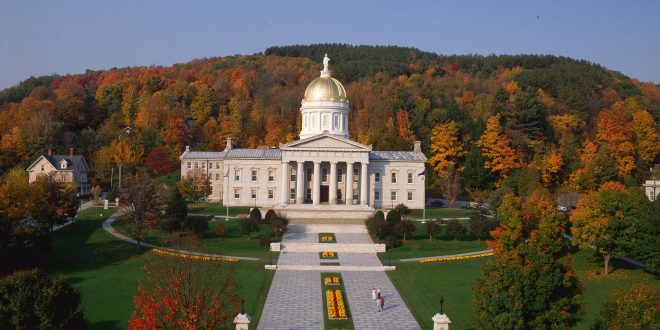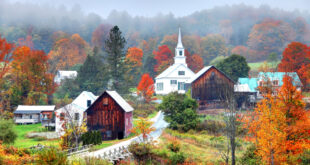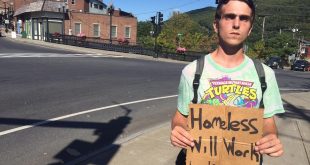Nearly three years before I moved to Vermont, on October 9, 1990, the Bennington Banner published my article entitled “Should the U.S. Be Downsized?” Four years later in Challenge(Nov.-Dec. 1994) I wrote: “The time has come both for the individual states and the federal government to begin planning the rational downsizing of America.” Continuing I suggested that Vermont might lead the way by helping “save our nation from the debilitating effects of big government and big business” and by “providing an independent role model for the other states to follow.”
In 1997 William H. Willimon and I published Downsizing the U.S.A., which not only called for Vermont independence but the peaceful dissolution of the American Empire. We argued that the U.S. government had become too big, too centralized, too powerful, too undemocratic, too militaristic, too imperialistic, too materialistic, and too unresponsive to the needs of individual citizens and small communities. However, since we were in the midst of the greatest economic boom in history, few Americans were interested in downsizing anything. The name of the game was “up, up, and away.” Only bigger and faster were thought to be better.
A year or so later I joined an organization called the New England Confederation whose objective was to have New England split away from the United States and establish itself as an independent nation-state. Unfortunately, the Confederation turned out to be mostly an Internet website rather than a real political organization. However, its website survived several years after the demise of the Confederation itself under the leadership of Bristol, Vermont resident Michael Patno.
For the most part, before September 11, 2001, my call for Vermont independence and the dissolution of the Empire fell on deaf ears. It was as though I were speaking to an audience of one, namely myself. But a year or so after 9/11 that gradually began to change. On March 4, 2003, two weeks before the second war with Iraq began, Michael Patno and I met for lunch in Burlington to discuss the possibility of organizing a serious, nonviolent independence movement in Vermont opposed to the tyranny of the U.S. government, Corporate America, and globalization and committed to the return of Vermont to its status as an independent republic as it was between 1777 and 1791. The following day I spoke at an anti-war rally at Johnson State College and decided to test-market the idea of an independent Vermont.
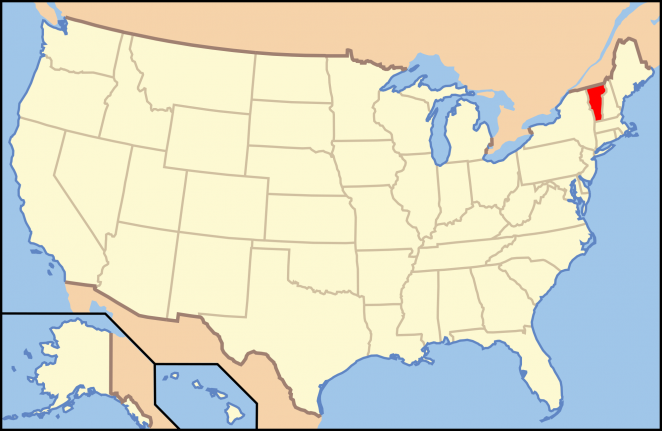
Basically, my pitch to the students was, “If you want to prevent future wars in places such as Afghanistan and Iraq, we have no choice but to break up the United States into smaller regions, and that process should begin with Vermont declaring its independence from the United States.” They were stunned, but they got it. Their positive response literally provided the energy for Michael Patno and I to launch the Second Vermont Republic.
Ten days after the bombing began in Baghdad on March 19, 2003, we held the first of four monthly meetings at the Village Cup in Jericho to discuss how such a movement might evolve. These meetings were attended by only a handful of people. Early on we decided not to become a political party but rather a civic club. The name “Second Vermont Republic” was proposed by Jeffersonville high school student Walker Brook and registered with the Secretary of State on June 19, 2003.
Over lunch in the backyard of the Bread & Puppet Theater Museum in Glover, Vermont on July 18, 2003, the puppeteers, under the leadership of Peter Schumann, agreed to cooperate with the Second Vermont Republic to promote Vermont independence. Since the outset, the Lake Parker Country Store in West Glover has been a focal point of SVR activity.
In conjunction with the release of my book The Vermont Manifesto on October 11, 2003, the first statewide meeting of the Second Vermont Republic was held in the New Building of Bread & Puppet Theater in Glover. The daylong meeting was attended by around fifty people. Wes Hamilton served as facilitator.
About the idea of Vermont independence, Ambassador George F. Kennan said, “I see nothing fanciful, and nothing towards the realization of which the efforts of enlightened people might not be usefully directed.” Harvard economist John Kenneth Galbraith added, “I must assure you of my pleasure in, and approval of, your views of the Second Vermont Republic.” “From the standpoint of puppeteers and their subversive papier-mâché, the Second Vermont Republic sounds like a very good idea to fight the megalomania of the globalizers,” echoed Peter Schumann.
On November 16, 2003, the Times-Argus published the first major article on the Second Vermont Republic. This was followed by Jay Walljasper’s piece in Utne on the Vermont independence movement. Chicago based economist and SVR member David Hale proposed in The Burlington Free Press on January 6, 2004, that Vermont should secede from the United States and join the British Commonwealth.
On January 4, 2004, SVR’s website www.vermontrepublic.org came on stream with Sam Young of West Glover as webmaster. In 2005 the website received an average of 3,000 unique visitors per month. It was substantially revised by Rob Williams in July 2006. Since August 2007 it has been managed by NEK Information Associates based in Glover, Vt.
Throughout the spring of 2004, we held monthly planning meetings at the Institute of Social Ecology in Plainfield. Then on June 19th SVR and Bread & Puppet Theater held a parade in downtown Montpelier which originated in front of the Firehouse and proceeded six blocks to the steps of the State House. Nearly 350 people attended the rally which followed in front of the State House. It included a performance by Bread & Puppet, live music, and a dozen or so speakers calling for Vermont independence. John Remington Graham, the author of A Constitutional History of Secession, was the keynote speaker. The rally ended with the reading of the Vermont Declaration of Independence. Copies of the new 32-page, glossy Journal of Vermont Independence edited by David White were also distributed. Nearly a year later, this journal evolved into Vermont Commons.
Two events which took place in November of 2004 put the Second Vermont Republic on the map, so to speak – statewide, nationally, and internationally. They were the November 2nd re-election of George W. Bush and a conference sponsored by SVR in Middlebury, Vermont three days after the election.
On November 5-7 forty people from eleven states and England attended a conference at the Middlebury Inn co-sponsored by SVR and the Fourth World of Wessex, England entitled “After the Fall of America, Then What?” The Fourth World, which published The Fourth World Review, a periodical inspired by Leopold Kohr and Fritz Schumacher, was committed to small nations, small communities, small farms, small shops, the human scale, and the inalienable sovereignty of the human spirit. Speakers included Kirkpatrick Sale, Donald Livingston, Rober Allio, Frank Bryan, and Thomas H. Naylor.
The underlying premise of the conference was that the United States had become unsustainable, ungovernable, and unfixable. If that were indeed the case, then do we go down with the Titanic or seek other alternatives? Among the options discussed at Middlebury were denial, compliance, and political reform, proven to be dead ends; revolution, rebellion, and implosion, equally problematic; and decentralization, devolution, and peaceful dissolution. The conference also included a mock town meeting open to the public with guest appearances by Ethan Allen (Jim Hogue) and Thomas Jefferson (Gus Jaccaci).
At the close of the meeting over half of the delegates including Kirkpatrick Sale, Donald Livingston, and Thomas H. Naylor signed The Middlebury Declaration which called for the creation of a movement that would “place secession on the national agenda, encourage secessionist organizations, develop communication among existing and future secessionist groups, and create a body of scholarship to examine and promote the ideas and principles of secessionism.” The Middlebury Institute headed by SVR member Kirkpatrick Sale is now engaged in the pursuit of these goals.
The combined effect of Bush’s re-election and the Middlebury Conference resulted in a significant increase in SVR’s membership, over 5,000 unique visits to our website in November, and an enormous amount of state, national, and international media attention. The Quebec newspaper Le Devoir published a front-page article on the conference.
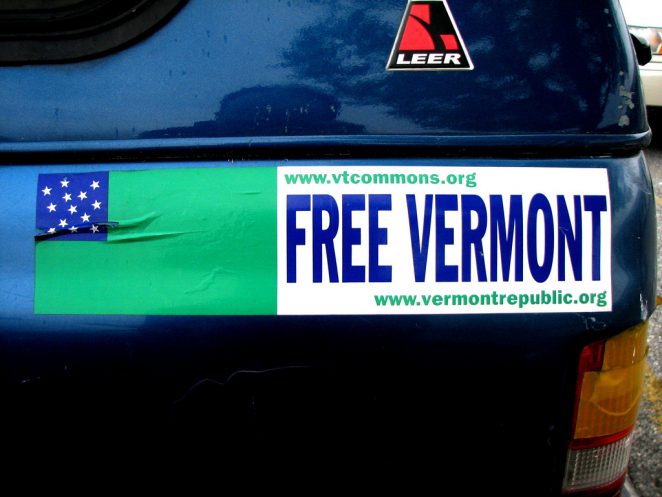
As a follow-up to the Middlebury Conference, SVR held several meetings in Montpelier at the Langdon Street Café, a worker-owned collective which supports creative dialogue, sustainability, local products, and community. Such a meeting was held on January 15, 2005 to commemorate the day in 1777 when Vermont declared its independence and became a separate republic for fourteen years. Ethan Allen (Jim Hogue) again made a guest appearance. One of the aims of the meeting was to promote the Vermont Independence Day Resolution being considered by the Vermont Legislature. During the previous September SVR members, Linda and John Whitney launched a statewide campaign calling for the Legislature to make January 15, 1777 Vermont Independence Day.
The resolution endorsed by Senator Jim Jeffords, Burlington Mayor Peter Clavelle, Lt. Governor Brian Dubie, and most members of the Vermont House and Senate was approved in an amended form in April. By then it had become a resolution naming January as Vermont history and independence month.
Then on March 4, 2005, a memorial service was held at the Langdon Street Café led by Rev. Ben Matchstick of Bread & Puppet Theater and General Ethan Allen (Jim Hogue) commemorating the day in 1791 when Vermont joined the Union. The service included a reading from Ecclesiastes with Chopin’s “Funeral March” playing in the background. A funeral procession with a New Orleans-style funeral band carried the flag-draped coffin containing the deceased First Vermont Republic to the State House where it was placed at the foot of the statue of Ethan Allen. The funeral received extensive statewide media coverage.
In April 2005 publisher Ian Baldwin, editor Rowan Jacobsen, and webmaster Dr. Rob Williams introduced an exciting print and online forum for exploring the idea of Vermont independence called Vermont Commons. The print version is a twenty-four-page bi-monthly newspaper distributed to paid subscribers and 200 venues through Vermont. Contributors to Vermont Commons have included Wendell Berry, Peter Clavelle, Kirkpatrick Sale, Bill McKibben, and James Howard Kunstler. Utne Magazine named Vermont Commons the “Best New Publication in 2005.” Rob Williams is now editor and publisher of Vermont Commons.
Thomas H. Naylor and Jim Hogue, who speaks French, participated in the fifteenth national Congress of the Parti Québécois in Quebec City on June 3-5 at the invitation of Vice Premiere Marie Malavoy. The invitation to the PQ Congress represented a form of political recognition of the Second Vermont Republic by a major political party in a neighboring country.
In 2005 SVR supporters participated in Fourth of July parades in Barton, Cabot, and Warren. The politically radical, funky, grassroots, seat-of-the-pants Warren parade attracts as many as 20,000 people each year to the Mad River Valley. The parade, whose homemade floats are held together by duct tape and baling twine, has no marching bands, only bands that march. It combines New England Americana with vintage Vermont culture and the residual effects of 1960s hippie culture. In the 2006 Warren parade, SVR had its own float. The Warren parade has become an annual event in which to promote Vermont independence.
To celebrate the signing of the Vermont Constitution in 1777, SVR held a mock town meeting on the Constitution House lawn in Windsor, Vermont on July 9, 2005. The meeting was led by Ben Matchstick and Rick Foley. Participants received their own personal Vermont passport. SVR appeared at this event again in 2006, which was covered by the Los Angeles Times.
On October 28, 2005, SVR held the first statewide convention on secession in the United States since North Carolina voted to secede from the Union on May 20, 1861. The daylong event took place in the House Chamber of the State House in Montpelier. Only in Vermont would such a meeting be possible.
Over 300 people heard keynote speaker James Howard Kunstler, author of The Long Emergency, warn that “the end of the cheap fossil fuel era will lead to the most serious challenge to our collective identity, economy, culture, and security since the Civil War.” He further warned that “turbulence will be the rule” and that “all bets will be off for politics, economics, and social cohesion.” Continuing he said, “the Federal government will be impotent and ineffectual – just as they were after Hurricane Katrina.”
He predicted that (1) American life will become intensely and profoundly local, (2) We will have to grow a lot more of our food in the regions where we live, and (3) We are going to have to reconstruct local economies, local networks of interdependency. He also took note of the fact that Vermont is uniquely situated to meet the challenge of the cheap oil endgame because of its small towns, small businesses, small farms, and the strong sense of community.
The objectives of the convention were twofold. First, to raise the level of awareness of Vermonters of the feasibility of independence as a viable alternative to a nation which has lost its moral authority and is unsustainable. Second, to provide an example and a process for other states and nations which may be seriously considering separatism, secession, independence, and similar devolutionary strategies.
Other convention speakers included Kirkpatrick Sale, author of Human Scale; Professor Frank Bryan, University of Vermont; J. Kevin Graffagnino, Executive Director, Vermont Historical Society; G. Roderick Lawrence, CEO, Stevenson Kellogg (Toronto); (Rev.) Ben T. Matchstick; and General Ethan Allen (aka Jim Hogue). The meeting began after General Allen arrived at the State House on a black stallion named “Duke.”
Two resolutions were approved by the convention delegates in the concluding session. One called for Vermont to return to its status as an independent republic as it had between January 15, 1777 and March 4, 1791. The other called for the Second Vermont Republic to seek membership in the Unrepresented Nations and Peoples Organization.
The convention attracted extensive statewide and national media attention. It was covered by Burlington Free Press, Times Argus, Brattleboro Reformer, Seven Days, Vermont Guardian, Associated Press (state/national), Channel 3 News, WDEV, Vermont Public Radio, Christian Science Monitor, American Conservative, Boston Globe, and the Alex Jones Show. The SVR website received nearly 10,000 unique visits during October. The meeting was attended by a major gubernatorial candidate and several legislators.
During the spring of 2006 SVR launched a campaign to promote Vermont sovereignty. The “Vermont Sovereignty Declaration” calls for the State of Vermont to reaffirm (1) its right of sovereignty, (2) its right to nullify acts of the central government deemed to be unconstitutional, (3) its right to secede from the Union, and (4) its right to call a statewide convention of the People to decide whether or not it remains in the Union.
On April 27, 2006, SVR held a legislative briefing on Vermont independence in the State House in Montpelier for legislators. The meeting was well attended and a lively discussion ensued.
In August 2006 SVR ceased being a membership organization and evolved into a think tank and citizens’ network.
On November 3-5, 2006 the Middlebury Institute hosted the first North American Convention on Secession in Burlington, Vermont. Delegates from eighteen states attended including representatives from Texas, Alaska, Louisiana, Hawaii, California, New Hampshire, and Tennessee to mention only a few. Kirkpatrick Sale was the keynote speaker.
In April 2007 the Center for Rural Studies of the University of Vermont released the results of its annual “Vermonter Poll” showing that thirteen percent of the eligible voters in Vermont support secession, up from eight percent a year earlier. An astonishing 74.3 percent of Vermont voters expressed the view that the U.S. government had lost its moral authority. A year later that percentage had jumped to 77.1.
On June 3, 2007 the Associated Press released a piece entitled “In Vermont, Nascent Secession Movement Gains Traction.” The article was picked up worldwide by hundreds of newspapers, websites, radio stations, and TV stations. As a result, SVR founder Thomas H. Naylor was interviewed by Fox News three times within two days including an appearance on The O’Reilly Factor. The SVR website received over 25,000 unique visits that month.
On October 3-4, 2007, the Second North American Secessionist Convention took place in Chattanooga, TN. The convention attracted delegates representing secessionist organizations in 36 states. The convention received worldwide media attention as a result of an AP story which described the meeting as bringing “the far left and the far right of American politics together.”
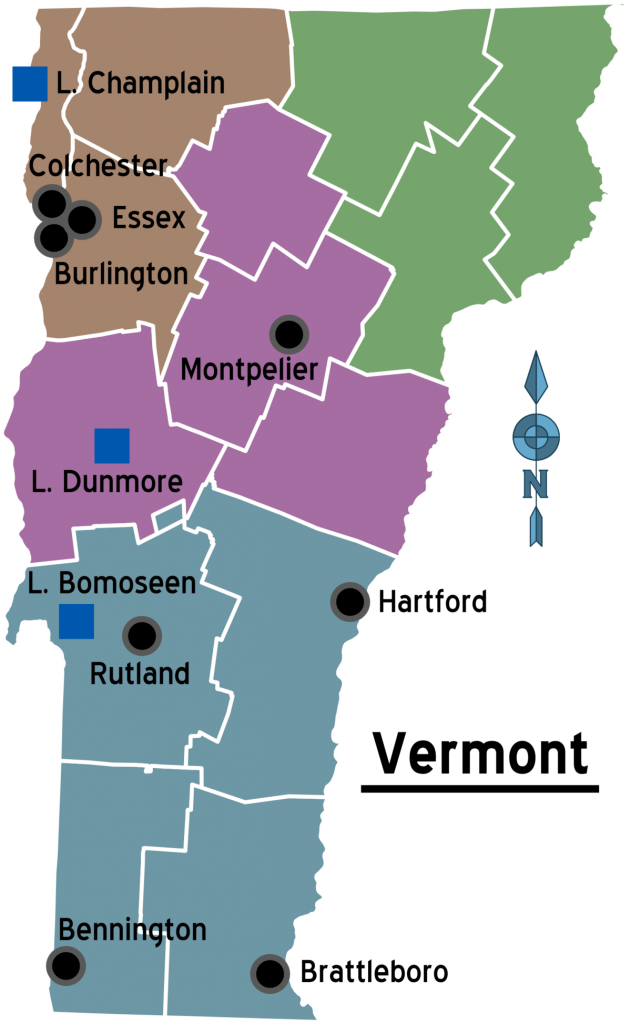
On November 7, 2008 SVR sponsored the Second Statewide Convention on Vermont Independence in the House Chamber of the State House in Montpelier. The convention took the form of an all-day forum, circus, and medicine show entitled “The Vermont Village Green: Alternative to Empire.” It consisted of a potpourri of radical music, art, theater, circus, conversation, politics, and community aimed at fomenting a Genteel Revolution against the American Empire. Participants included trends forecaster Gerald Celente, New Mexico writer Chellis Glendinning, Alaskan Independence Party leader Lynette Clark, Bread & Puppet Theater, folk musician Pete Sutherland, peak oil writer James Howard Kunstler, Rural Vermont leader Amy Shollenberger, UVM student Tyler Wilkinson-Ray, and Kirby businessman Dennis Steele. A new grassroots Vermont independence group was launched by Mr. Steele.
The following week the Third North American Secessionist Convention took place in Manchester, New Hampshire on November 14-15.
On May 22, 2009, Kirby businessman Dennis Steele launched Radio Free Vermont, an Internet radio station devoted exclusively to playing music produced by Vermont artists. Today Radio Free Vermont has listeners in over 130 countries.
The Second Vermont Republic issued 500 SVR Scott Nearing 50 clover silver tokens in October of 2009 for those contributing financially to the Vermont independence movement. The tokens contained one ounce of .999 fine silver. The limited supply of tokens was sold out within a few months.
On January 15, 2010, Vermont Independence Day, ten secessionists announced their candidacy for the November 2nd election including candidates for Governor, Lt. Governor, seven Senate seats, and one House seat. Dennis Steele and Peter Garritano, our candidates for Governor and Lt. Governor respectively, each ran third in their statewide races.
Time magazine named SVR one of the “Top 10 Aspiring Nations” in the world in January 2011. Matt Cropp and Dan Murphy launched the Vermont Independence Alliance, a statewide grassroots political organization in July 2011.
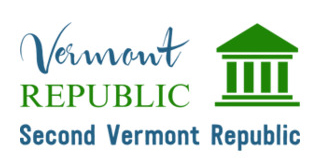 Vermont Republic Second Vermont Republic
Vermont Republic Second Vermont Republic
